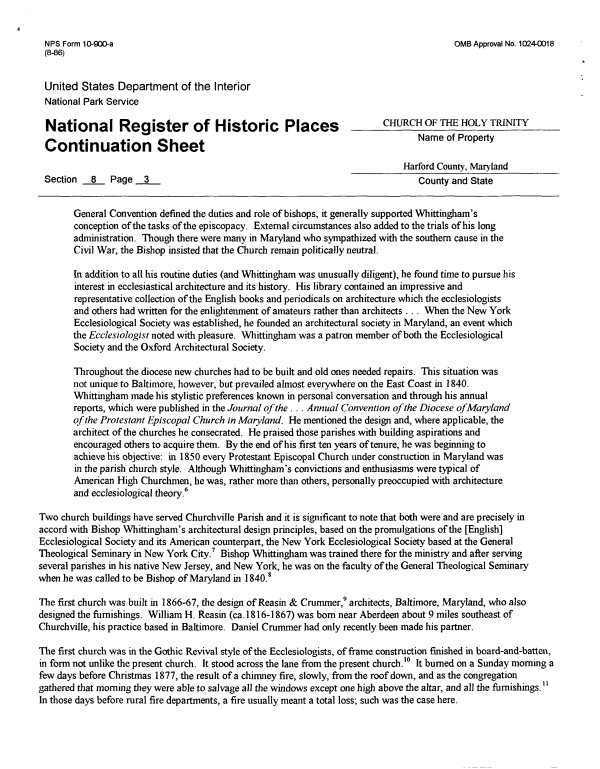 |
||||
|
DEPARTMENT OF HOUSING AND COMMUNITY DEVELOPMENT, MARYLAND HISTORICAL TRUST (Historic Sites Survey) var.d. MSA SE16-8 Image No: se16-8-0357 Enlarge and print image (82K) |
 |
||||
|
DEPARTMENT OF HOUSING AND COMMUNITY DEVELOPMENT, MARYLAND HISTORICAL TRUST (Historic Sites Survey) var.d. MSA SE16-8 Image No: se16-8-0357 Enlarge and print image (82K) |
| NFS Form 10-900-a OMB Approval No. 10240018 (8-86) United States Department of the Interior National Park Service National Register Of Historic Places CHURCH OF THE HOLY TRINITY -i .. A. f^t . Name of Property Continuation Sheet Harford County, Maryland Section 8 Page 3 County and State General Convention defined the duties and role of bishops, it generally supported Whittingham's conception of the tasks of the episcopacy. External circumstances also added to the trials of his long administration. Though there were many in Maryland who sympathized with the southern cause in the Civil War, the Bishop insisted that the Church remain politically neutral. In addition to all his routine duties (and Whittingham was unusually diligent), he found time to pursue his interest in ecclesiastical architecture and its history. His library contained an impressive and representative collection of the English books and periodicals on architecture which the ecclesiologists and others had written for the enlightenment of amateurs rather than architects . . . When the New York Ecclesiological Society was established, he founded an architectural society in Maryland, an event which the Ecclesiologist noted with pleasure. Whittingham was a patron member of both the Ecclesiological Society and the Oxford Architectural Society. Throughout the diocese new churches had to be built and old ones needed repairs. This situation was not unique to Baltimore, however, but prevailed almost everywhere on the East Coast in 1840. Whittingham made his stylistic preferences known in personal conversation and through his annual reports, which were published in the Journal of the . . . Annual Convention of the Diocese of Maryland of the Protestant Episcopal Church in Maryland. He mentioned the design and, where applicable, the architect of the churches he consecrated. He praised those parishes with building aspirations and encouraged others to acquire them. By the end of his first ten years of tenure, he was beginning to achieve his objective, in 1850 every Protestant Episcopal Church under construction in Maryland was in the parish church style. Although Whittingham's convictions and enthusiasms were typical of American High Churchmen, he was, rather more than others, personally preoccupied with architecture and ecclesiological theory.6 Two church buildings have served Churchville Parish and it is significant to note that both were and are precisely in accord with Bishop Whittingham's architectural design principles, based on the promulgations of the [English] Ecclesiological Society and its American counterpart, the New York Ecclesiological Society based at the General Theological Seminary in New York City.7 Bishop Whittingham was trained there for the ministry and after serving several parishes in his native New Jersey, and New York, he was on the faculty of the General Theological Seminary when he was called to be Bishop of Maryland in 1840.8 The first church was built in 1866-67, the design of Reasin & Crummer,9 architects, Baltimore, Maryland, who also designed the furnishings. William H. Reasin (ca. 1816-1867) was bom near Aberdeen about 9 miles southeast of Churchville, his practice based in Baltimore. Daniel Crummer had only recently been made his partner. The first church was in the Gothic Revival style of the Ecclesiologists, of frame construction finished in board-and-batten, in form not unlike the present church. It stood across the lane from the present church.10 It burned on a Sunday morning a few days before Christmas 1877, the result of a chimney fire, slowly, from the roof down, and as the congregation gathered that morning they were able to salvage all the windows except one high above the altar, and all the furnishings.11 In those days before rural fire departments, a fire usually meant a total loss; such was the case here. |